“I need a laptop. What should I buy?”
Work in I.T. for more than a week and you will be asked this question, I guarantee it. Sounds simple enough but it's not an easy question to just say "Buy X and not Y".
I've been buying laptops since the 1980's and I've been down this road myself quite a bit.

This should help give you a bit of guidance to help you find something that really suits your needs; while I can offer no guarantees I have found that you're much more likely to find a laptop you like, will actually use and will get much much more value out of.
Remember - if you buy something you hate then your cost is 100% wasted money!
The Five Key Points
These five points are SO important; I can't stress them enough.
I've found that these make the difference between something you loathe and something you love:
|
|
This won't be cheap: laptops used to cost many thousands of pounds (or dollars) but nowadays they can be had for a few hundred; that's wonderful but they're still awfully expensive things to buy and even more awfully expeensive to get wrong. Don't be pressured or jump into anything - unless you're *truly* desperate, your business is losing money or you're missing assignment deadlines taking a little time will REALLY pay off. |
|
|
Buy something you'll actually like: Apple's marketing people used to say: "The most powerful computer in the office If you like the laptop you buy you really ARE going to use it more – you'll get so much more out of it and your money is so much better spent. If you hate the keyboard, find the screen hard to read, find it too heavy or the battery doesn't last long enough - you really won't get as much use out of it. You'll have wasted your money no matter how good a deal you manged to get. |
|
|
Think like an accountant: Break the purchase price down and think of how long you’re planning to have it for. If you work out how much it will "cost" per day then you can think - is this really going to be worth $3 per day to me? Is it worth £12 per day to me? Your budget will tell you how much you can spend - this will help tell you how much you SHOULD spend. |
|
|
Think ahead - not backward: If like me you don't have ready access to a time machine - you have to think of how you're going to be using it in 3 months time or 6 months or 18 months time. If you think "oh 6 months ago I had to go to lectures all the time so portability is a big deal" - but now you will only use it at home - then battery life and mobility isn't as important. Be broader in your thinking too - Are you going to take it to work? Use it on a train to watch movies, play games or browse Facebook? Are you going to be using it in libraries and lecture halls or just at home? Is it going to the cabin on the weekend with you or will it never leave the confines of the kitchen table? |
|
|
Try them out - hands on is SO VERY IMPORTANT: All laptops have aspects that you will love and loathe - there's no perfect machine out there; some have bits you can live with, some bits you can't - and some bits you'll love.
|
Screen
There are three things that make up screens now:
- Gloss vs matt finish
- Size (physical)
- Resolution (how many pixels on screen)
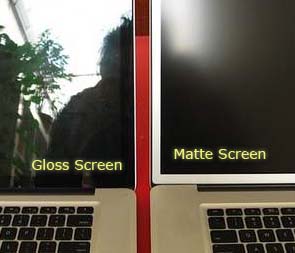 Gloss screens make colour look more vibrant and videos look crisper and clearer – but this is at the expense of severe reflection problems. Some are downright unusable in bright areas; even office lighting can make them very hard to see. You usually find glossy screens on “consumer” laptops (for use at home) as it’s easier to control lighting and they tend to be used more at night; corporate laptops are used in offices and outdoors more and tend to have matt screens which diffuse reflective light and make the image easier to see but as a trade-off the colour isn’t quite as vibrant or vivid. Have a look at both in a store or showroom – angle the screen to see if this bothers you and see if the reflections bother you. For some people it’s not an issue; just as when you look through a window and focus on what is outside so too can some manage to do this with a screen.
Gloss screens make colour look more vibrant and videos look crisper and clearer – but this is at the expense of severe reflection problems. Some are downright unusable in bright areas; even office lighting can make them very hard to see. You usually find glossy screens on “consumer” laptops (for use at home) as it’s easier to control lighting and they tend to be used more at night; corporate laptops are used in offices and outdoors more and tend to have matt screens which diffuse reflective light and make the image easier to see but as a trade-off the colour isn’t quite as vibrant or vivid. Have a look at both in a store or showroom – angle the screen to see if this bothers you and see if the reflections bother you. For some people it’s not an issue; just as when you look through a window and focus on what is outside so too can some manage to do this with a screen.
- Size – this is a big factor in determining the laptop’s overall size, indeed it’s the single biggest factor. Some are enormous – 17 and 18 inch screens adorn some larger gaming laptops now, they are big and easier to read from a distance or for use for long periods of time. The trade-off is a big hit on battery life (it takes a lot more power to run a larger screen), the size issue (a problem for carrying and limiting where you can set it up) and reduced privacy and discretion if you use it in a public place. Again this goes to personal preference and intended use – if it’s desk-bound, your eyesight is strained by small images or you want to use it at more of a distance then a larger screen may be better.
- Resolution – this is how many dots are on a screen at any given time. This is usually related to size as well; really small screens with a lot of pixels makes them very tiny and hard to see, this is fine for making an image clearer but may not benefit you that much in the long run and may even make text too small to read properly. Resolution that is too low makes everything larger but also makes the picture look more blocky and you can’t fit as many things on the screen at once even if it’s a larger screen; remember the icons, text, etc. are all related to the number of dots rather than the physical size.
Some screens now have so-called “retina” or “retina-like” displays – extremely high resolution screens that are intended to have pixels so small you can’t easily see them individually. This works with newer versions of windows, MacOS, Linux, etc. which draw text and images in a different way – so an icon that is, say, 1cm-square in size will still be the same size but will have more detail and clarity on these newer screens. They are harder to “drive” (for the computer to generate the picture) and some games may not work on them properly; they are becoming more common now however as they offer more flexibility and photographs can look extremely detailed on their screens as well as making text sharper and more vibrant.
Keyboard and Trackpad
Keyboard feel can be a bigger deal than most people realise. Some keyboards are simply awful to use, others can look dreadful but actually be quite acceptable. Some people don’t touch type or really won’t be doing that much writing on their laptop so this won’t be quite as important to them – it’s a matter of trying before you buy and go with your own personal opinion. What I think is horrendous the next person may find quite acceptable – and vice versa.
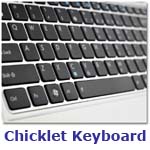 Most laptops, even larger ones these days have “chicklet” keys though there are some that buck this trend. These keys have a “minimalist” appearance, are very thin and make the laptop easier to manufacture and design; they are less likely to rub against the screen when it’s closed for instance. They can be nasty to use though; they have short ‘travel’ (how far the key goes down when you hit it) and many have a spongy, mushy feel which can give you real problems if you type a lot. I can’t stand poor quality keyboards as they give me significant physical irritation in my fingers; it’s a big factor in determining what I will and won’t buy. I’ve made the mistake of buying a laptop on more than one occasion that had a less than stellar keyboard and I’ve regretted it enormously afterwards.
Most laptops, even larger ones these days have “chicklet” keys though there are some that buck this trend. These keys have a “minimalist” appearance, are very thin and make the laptop easier to manufacture and design; they are less likely to rub against the screen when it’s closed for instance. They can be nasty to use though; they have short ‘travel’ (how far the key goes down when you hit it) and many have a spongy, mushy feel which can give you real problems if you type a lot. I can’t stand poor quality keyboards as they give me significant physical irritation in my fingers; it’s a big factor in determining what I will and won’t buy. I’ve made the mistake of buying a laptop on more than one occasion that had a less than stellar keyboard and I’ve regretted it enormously afterwards.
Without going into too much detail, it’s very important to:
- Try them out; see what the key feel is like
- Don’t try one model in the range and expect all others to be the same even if they look the same. Some brands make their keyboards all look similar (corporate “design language”) but they are very different underneath for technical and marketing reasons
A number of keyboards have spill resistance so they have some resistance to water and liquid spills; this may be useful for those with kids and pets around or who intend to take the machine outdoors a lot
Some have a compressed layout to save space – this again is a personal impression issue. I’ve found some that were extremely frustrating to use as keys such as page-up and page-down were “shifted” (you had to hit the “FN” key and then another one to make this work); that’s fine for infrequently used keys but can be very irritating for regularly used keys, especially for gaming
Ultimately this is a personal choice – try it yourself, see what you’re happy with and make your own decision. You’re the one who’ll have to live with it so take a bit of time – open Notepad (or an equivalent) and type something; if you make a lot more mistakes than usual this can be a sign that you’re not taking to that keyboard well; if you make a lot of mistakes and don’t like the feel then I’d avoid that machine altogether.
Weight and Size
There are dozens of shapes, sizes and weights now. These are referred to as “form factors” – generally there are:
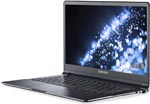 “Ultra portables”, “Subnotes” or “Ultrabooks” – these are small, light and often have very good battery life but lack expandability, ports, processing power and may compromise in usability too. They suit people who will carry them around a lot – they can be discrete and sleek and are considered “fashionable” by some. If you want to use a laptop in a café, on a train, at a meeting, etc. then this is a good option but be aware; they often can’t be expanded (e.g. most won’t allow you to add more memory) so be careful to not “under-buy” (buying something too low in specification, e.g. with too little memory).
“Ultra portables”, “Subnotes” or “Ultrabooks” – these are small, light and often have very good battery life but lack expandability, ports, processing power and may compromise in usability too. They suit people who will carry them around a lot – they can be discrete and sleek and are considered “fashionable” by some. If you want to use a laptop in a café, on a train, at a meeting, etc. then this is a good option but be aware; they often can’t be expanded (e.g. most won’t allow you to add more memory) so be careful to not “under-buy” (buying something too low in specification, e.g. with too little memory).
 Larger “ultrabooks” – these often have a larger screen and usually are a bit heavier but still try to remain thin. They sometimes have more ports and a larger keyboard too – they are for those who want thin and light but want a screen that is easier to read. These typically go up to around 2kg in weight (the upper-barrier is hotly debated, some think no more than 1.8kg is acceptable). Sometimes these can be more expandable however many still aren’t.
Larger “ultrabooks” – these often have a larger screen and usually are a bit heavier but still try to remain thin. They sometimes have more ports and a larger keyboard too – they are for those who want thin and light but want a screen that is easier to read. These typically go up to around 2kg in weight (the upper-barrier is hotly debated, some think no more than 1.8kg is acceptable). Sometimes these can be more expandable however many still aren’t.
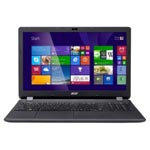 Conventional laptop – this is the most common and is usually the most diverse category. They can be cheaper as they’re easier to build – they allow for expandability (upgrading hard drive, adding memory, etc.) and can also be built with more powerful parts; they often have screens that range form 14.1” to as high as 16”, they can weight as much at 3.5kg typically. Again this isn’t a hard and fast rule – it’s a marketing designation afterall. These suit a lot of people – they are easier and more natural to use, many carry bags suit them well and they can still be used in many environments (e.g. cafes) without too much problem but you have to be a bit more careful in placement, etc. They also tend not to have battery life that is as good – this is usually due to larger screen size and more powerful components, adding a lot more battery to service this greater power draw makes them too heavy to carry comfortably.
Conventional laptop – this is the most common and is usually the most diverse category. They can be cheaper as they’re easier to build – they allow for expandability (upgrading hard drive, adding memory, etc.) and can also be built with more powerful parts; they often have screens that range form 14.1” to as high as 16”, they can weight as much at 3.5kg typically. Again this isn’t a hard and fast rule – it’s a marketing designation afterall. These suit a lot of people – they are easier and more natural to use, many carry bags suit them well and they can still be used in many environments (e.g. cafes) without too much problem but you have to be a bit more careful in placement, etc. They also tend not to have battery life that is as good – this is usually due to larger screen size and more powerful components, adding a lot more battery to service this greater power draw makes them too heavy to carry comfortably.
 Large laptops (desktop replacement) – these usually have more powerful processors, larger hard drives, can take more memory and have larger screens. They often have larger keyboards and weigh much more; some are considered to be “transportable” rather than “portable” as they can weight more than 4.5-5kg, sometimes even more than this. These typically spend their lives deskbound – they are often bought by someone who would otherwise have bought a desktop and aren’t often moved around (though some are popular with consultants wanting a larger desktop machine in the workplace). There are some very cheap versions which are low-end, low powered machines with large screens; these suit those who want a screen that’s large and easy to read. Most however are “higher end” machines which have more powerful components, special sound systems and more powerful graphics and CPU; they tend to be priced higher as a result. Battery life is typically very poor; they often have an hour or less in real terms but this doesn’t usually bother owners too much as they’re rarely far from a powerpoint.
Large laptops (desktop replacement) – these usually have more powerful processors, larger hard drives, can take more memory and have larger screens. They often have larger keyboards and weigh much more; some are considered to be “transportable” rather than “portable” as they can weight more than 4.5-5kg, sometimes even more than this. These typically spend their lives deskbound – they are often bought by someone who would otherwise have bought a desktop and aren’t often moved around (though some are popular with consultants wanting a larger desktop machine in the workplace). There are some very cheap versions which are low-end, low powered machines with large screens; these suit those who want a screen that’s large and easy to read. Most however are “higher end” machines which have more powerful components, special sound systems and more powerful graphics and CPU; they tend to be priced higher as a result. Battery life is typically very poor; they often have an hour or less in real terms but this doesn’t usually bother owners too much as they’re rarely far from a powerpoint.
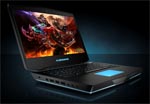 Gaming laptops – these are often at the top end of the market and can be very heavy as they contain very powerful components, often they rival powerful desktop computers for performance. They have very powerful processors but most often have powerful graphics chips – this allows them to play modern games which require powerful graphics processing, even when out and about. They often have poorer battery life and are less mobile; many are larger and thicker as they need special cooling systems to keep their powerful chips working properly. There are a small number of smaller gaming laptops now; these allow for gaming on the move but they tend to be very expensive and compromise in some areas (they can be thicker and heavier than other small laptops). Screen resolution is critical to these laptops- very high resolution requires a lot of graphics power for gaming so they often have moderate resolution screens to ensure that they work with most games without sacrificing performance and detail, this is particularly so for smaller machines (the smaller and lower resolution screen needs less graphics power which makes them smaller and lighter on battery). Many are designed for gamers and are ostentatious and even gaudy in design; they are rarely discreet and often have noisy cooling systems that keep them working so they don’t suit quiet environments as well. Some new machines even have desktop-type keyboards and are very large and heavy – and can be VERY expensive costing as much as 6-7 times a normal laptop.
Gaming laptops – these are often at the top end of the market and can be very heavy as they contain very powerful components, often they rival powerful desktop computers for performance. They have very powerful processors but most often have powerful graphics chips – this allows them to play modern games which require powerful graphics processing, even when out and about. They often have poorer battery life and are less mobile; many are larger and thicker as they need special cooling systems to keep their powerful chips working properly. There are a small number of smaller gaming laptops now; these allow for gaming on the move but they tend to be very expensive and compromise in some areas (they can be thicker and heavier than other small laptops). Screen resolution is critical to these laptops- very high resolution requires a lot of graphics power for gaming so they often have moderate resolution screens to ensure that they work with most games without sacrificing performance and detail, this is particularly so for smaller machines (the smaller and lower resolution screen needs less graphics power which makes them smaller and lighter on battery). Many are designed for gamers and are ostentatious and even gaudy in design; they are rarely discreet and often have noisy cooling systems that keep them working so they don’t suit quiet environments as well. Some new machines even have desktop-type keyboards and are very large and heavy – and can be VERY expensive costing as much as 6-7 times a normal laptop.
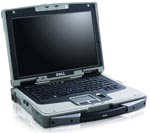 Ruggedized machines – these are special purpose laptops and are often the most expensive on the market but usually have very modest processing power and storage. They are designed for rough environments such as industrial sites, outdoor activities, oil rigs, war zones, etc. They are designed to be resistant to dust, humidity, impacts and vibration and are usually aimed at industrial and military buyers. It is rare to see these bought by consumers except where they are used in rough environments; some hikers and campers would use this type of machine out in the field but their cost is often too prohibitive for most people (also their lack of power makes them a poorer choice for those who don’t need the ruggedness).
Ruggedized machines – these are special purpose laptops and are often the most expensive on the market but usually have very modest processing power and storage. They are designed for rough environments such as industrial sites, outdoor activities, oil rigs, war zones, etc. They are designed to be resistant to dust, humidity, impacts and vibration and are usually aimed at industrial and military buyers. It is rare to see these bought by consumers except where they are used in rough environments; some hikers and campers would use this type of machine out in the field but their cost is often too prohibitive for most people (also their lack of power makes them a poorer choice for those who don’t need the ruggedness).
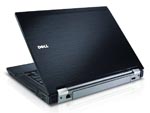 Professional/corporate laptops – these usually are more conservative in their design and have higher quality screens, keyboards and touchpads but lack the same standard of media and other support. They are designed for big business and professional use and have support for asset tag management, security services that encrypt the drive and its contents, fingerprint readers, etc. They are often much more expensive as well; they can be preferable for those who are going to do a lot of writing or need high-grade on-site support. Their design is usually sleeker and more “professional” looking so they fit in more with a corporate environment. Look at these if your needs are more business/professional in nature.
Professional/corporate laptops – these usually are more conservative in their design and have higher quality screens, keyboards and touchpads but lack the same standard of media and other support. They are designed for big business and professional use and have support for asset tag management, security services that encrypt the drive and its contents, fingerprint readers, etc. They are often much more expensive as well; they can be preferable for those who are going to do a lot of writing or need high-grade on-site support. Their design is usually sleeker and more “professional” looking so they fit in more with a corporate environment. Look at these if your needs are more business/professional in nature.
 Tablet/Hybrid machines – These are some of the newest types of laptops. They can convert into tablets – some fold down or fold back to act as a tablet machine, some detach from their keyboards and others have unique flip or sliding arrangements which make them very innovative. They tend to be expensive and less powerful and sometimes compromise on battery life; their keyboards tend to be fairly basic as well but they can suit some users very well, particularly those who will find themselves using their laptop in “tablet” mode. This can suit some users who watch films, use tablet controls for browsing or prefer the touch interface for most things; a popular choice for those who use it as a tablet most of the time and convert it to “keyboard mode” for typing email replies, documents, etc.
Tablet/Hybrid machines – These are some of the newest types of laptops. They can convert into tablets – some fold down or fold back to act as a tablet machine, some detach from their keyboards and others have unique flip or sliding arrangements which make them very innovative. They tend to be expensive and less powerful and sometimes compromise on battery life; their keyboards tend to be fairly basic as well but they can suit some users very well, particularly those who will find themselves using their laptop in “tablet” mode. This can suit some users who watch films, use tablet controls for browsing or prefer the touch interface for most things; a popular choice for those who use it as a tablet most of the time and convert it to “keyboard mode” for typing email replies, documents, etc.
Battery life
This depends very much on what type of machine it is. Some machines have an extremely long battery life that can run a whole day realistically without needing recharging, others can be so short that their battery is little more than a way of keeping the machine running if it’s moving or someone trips over the chord.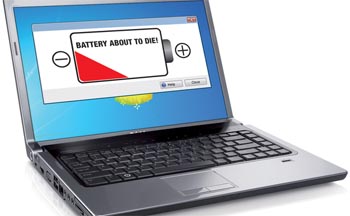
- Some ultrabook type machines can have extraordinary battery life; they are designed for mobility and use away from power points and often have lower powered processors, smaller screens and special “solid state” disks (SSDs) which don’t have a motor and use much less power. Some can have more than 12 hours of battery life but this also depends on how the machine is used; some can run for 8 hours on light use but 2 hours with heavy use so it’s hard to get a reliable rating on this
- Many laptops have removable batteries – typically larger machines have this feature. This lets you carry more than one battery with you or replace a battery as it gets older and holds less charge; however others have a fixed or internal battery which needs a technician to replace (e.g. Apple laptops are designed this way, many ultrabook machines are as well)
- Really large laptops tend to have moderately sized batteries – huge batteries are very heavy to carry and ultimately won’t give a large machine a particularly long battery life anyway
Generally I advise the following:
- When looking at a machine try to see its power chord and “power brick” – some are very small and easy to carry, others are disproportionately large and difficult to carry.
- Work out how much you’re going to really need to use it away from mains power. This may be less than you think – for example many modern aircraft and trains have power points for travellers to use, it’s still rare in some countries but is becoming more common. Conversely however if you have poor battery life you may not find yourself using it away as much – this means you’re getting much less value for money from the machine you buy if you are too afraid to use it out and about. If you’re writing an assignment or an article for a site it can be much nicer to do this outside or at the park; here good battery life is its own reward.
- If you’re going to need long stretches away from a power point then a very long battery life or at least a user-changeable battery is essential. Some laptops also let you clip in a larger or extended battery though these can add significantly to weight and bulk – look into this first, only a fairly small number of brands still offer this option
Power, Processor and Memory
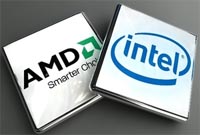 Most users rarely come close to using the full power of their PC’s processor (CPU). There are several types of processors found in modern laptops:
Most users rarely come close to using the full power of their PC’s processor (CPU). There are several types of processors found in modern laptops:
- Low-end (cheap) processors which are fine for basic use (e.g. Intel Celerons)
- “ULV” or ultra-low-voltage chips which use very little power and need less cooling but have less processing power overall
- Mid-range processors (e.g. Intel Core-i5 Mobile) which offer a balance between power consumption and performance
- High-end processors (e.g. Intel Core-i7 quad-core processors) which use more power but offer faster performance (and also generate more heat). Some have two cores, some have four; the more cores can use more power but are capable of more concurrent processing, this is useful for programmers, designers, developers, power users and gamers
- Laptops which desktop chips in them – these are not as common any more but still exist, they use desktop CPUs to deliver more processing power but use more electric power and require more cooling as a result. They are more likely to be found in larger systems and some gaming machines
Most people won’t require as much processor power unless they are running tasks which are more intensive, e.g. they are doing heavy graphical work or are running share market trading simulators or virtual machines. Your needs will be determined by what you use the machine for; if it’s used as a “satellite” machine (you have a main desktop at home and use this for mobile use only) then you often can afford to go for something with less direct power as the “heavy lifting” is done by the desktop at home.
To find out what you’re going to need look for recommendations based on the software you’re going to be using; if you’re using something special or unusual it may stipulate greater requirements or run significantly faster if you have a powerful processor however if you buy something too powerful and don’t use it you’ll just waste money and may have to compromise on weight, battery life and size unnecessarily.
Memory
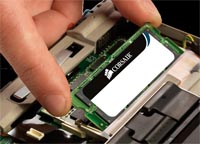 As a baseline you’ll need at least 8 gig of RAM – some laptops still ship with 4 gig of RAM but this simply isn’t enough these days. Many machines are not expandable – you can’t add more memory to them later – so you are stuck with whatever you bought in the first place. This is a big problem if you “under-buy” as you’ll be stuck with slower performance, more restrictions and more instability and you won’t be able to do anything about it down the track.
As a baseline you’ll need at least 8 gig of RAM – some laptops still ship with 4 gig of RAM but this simply isn’t enough these days. Many machines are not expandable – you can’t add more memory to them later – so you are stuck with whatever you bought in the first place. This is a big problem if you “under-buy” as you’ll be stuck with slower performance, more restrictions and more instability and you won’t be able to do anything about it down the track.
Typically smaller machines and Ultrabooks are not expandable – it depends on the manufacturer. Some brands offer models that are significantly more expensive for a bit more memory; you have to be very careful.
If you are running something that requires a lot of memory (e.g. virtual machines) then you may need to buy a machine that has a lot more memory installed or can be easily upgraded; larger machines usually have expansion sockets that can be accessed (often called “SODIMM” sockets), this depends on the brand and the model. Some have only one, others have two; look into this and find out what the machine has. Also look at the machine’s upper-memory limit – some have two sockets but they won’t recognise more than 8gig of RAM even though you could easily buy and insert two 8gig SODIMM modules; the laptop is designed to only use a maximum of 8gig of RAM in that case. Be extremely careful of machines with this limitation.
It pays to find out precisely what can and can’t be done with that particular machine – look for the specific model number and find out what is available. For better information on most models there is an excellent memory information database online provided by Crucial (a memory company) – this can be found at http://www.crucial.com/usa/en/memory-info and will give you specific technical information on the memory that can be used with your particular laptop.
Graphics and Gaming
Most laptops have either one of two types of graphics:
Onboard graphics – this uses the graphics hardware that comes with the system’s CPU. It uses much less power but is far less powerful; it’s fine for most use and even some moderate gaming however more demanding games and graphic programs tend to need more graphics power than this can deliver. You also lose some of the system’s RAM to support this system – you can usually set this up but it’s not uncommon to lose half a gigabyte of RAM as it’s allocated to the machine’s onboard graphics system
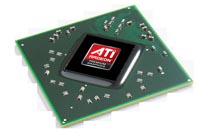 Discrete (dedicated) graphics – this is a solution that is similar to a proper graphics card in a desktop computer. It has a more powerful graphics chip, usually has its own discrete graphics memory and is much better suited for gaming, 3D design work, etc. It also uses significantly more power and requires more cooling which can be rather noisy if loud cooling fans need to be used. This can lead to greater size and more weight and significantly increased cost; all gaming laptops have this type of system installed as it is needed to play most modern games. Look online for performance tests and recommendations for that particular laptop’s graphics chip; also look at the resolution of the screen and see how the two match, a lower resolution screen can be driven by a less powerful graphics chip successfully but if you’re connecting an external monitor then it pays to source one that’s more powerful.
Discrete (dedicated) graphics – this is a solution that is similar to a proper graphics card in a desktop computer. It has a more powerful graphics chip, usually has its own discrete graphics memory and is much better suited for gaming, 3D design work, etc. It also uses significantly more power and requires more cooling which can be rather noisy if loud cooling fans need to be used. This can lead to greater size and more weight and significantly increased cost; all gaming laptops have this type of system installed as it is needed to play most modern games. Look online for performance tests and recommendations for that particular laptop’s graphics chip; also look at the resolution of the screen and see how the two match, a lower resolution screen can be driven by a less powerful graphics chip successfully but if you’re connecting an external monitor then it pays to source one that’s more powerful.
Hybrid / switchable – some laptops let the user switch between onboard graphics and discrete graphics, sometimes without having to restart the machine. This can be extremely useful – if you don’t need the power of discrete graphics and need to save battery life then this will use the onboard graphics instead. Fire up a game or something more intensive and the system switches over to the more powerful (and power hungry) discrete graphics system. This system is becoming more common as operating systems do a better job of supporting it; expect to see this become more commonplace in the future.
Special needs for rendering and 3D design applications – some programs are designed to make use of the graphics chipset to perform other functions, for example a range of 3D design applications can use certain NVIDIA chips to give them additional processing horsepower to speed up complex rendering tasks. This depends heavily on the program itself and not all graphics chips are well supported even if they are the recommended brand; if you are looking to run this type of program it will pay to do some research and find out the graphics chip that is used in the laptop you are looking at, careful planning here can make a significant difference in performance.
Storage
 There are three types of internal storage in laptops – Hard Disks (mechanical), mSATA solid state disks and SSD (solid state disk) devices. There are also USB drives and SD-cards that can be plugged in however these are considered to be “external” – we will look at internal storage only here.
There are three types of internal storage in laptops – Hard Disks (mechanical), mSATA solid state disks and SSD (solid state disk) devices. There are also USB drives and SD-cards that can be plugged in however these are considered to be “external” – we will look at internal storage only here.
The amount of storage space depends on your usage requirements; some people will not need much storage as they will be storing their files online or be storing everything on their network at work or at home. Others will need more internal storage as they will be using the machine away from home more often. If you’re going to be away from home or long periods of time, need store many large files or this is your primary or only computer then more storage space may be essential.
The type of storage is also important:
- Mechanical hard disks are cheapest, slowest and highest capacity drives. They have been around a long time – they are also potentially more prone to failure as they are mechanical, generally though these drives handle mobile use very well and can cope with bumps and knocks to a surprising extent. There are also new “hybrid” drives which have some flash storage attached (this is faster than the mechanical drive) – this has the effect of speeding up the drive though it won’t be as fast as a solid state disk.
- SSD drives – these are smaller in capacity and more expensive but are significantly faster and use far less power. They can be 5-10 times faster than a mechanical drive and can make the overall performance of a laptop significantly better; they also use far less power and have no moving parts so they don’t generate much heat and aren’t susceptible to shock, vibration, etc. In the past they were significantly more expensive and far smaller than mechanical drives however you can now obtain SSD drives that have almost as much space as mechanical ones; they tend to be 2-4 times the cost on average but are a good investment especially if you need better performance of battery life
- mSATA drives – these are small special internal drives which are usable on some laptops; they are similar to SSD drives in performance and capacity. Some smaller laptops such as ultrabooks use these internally but they’re not usually “user-serviceable” (they need to be fitted by a technician and may void warranty in some cases if they’re removed); this depends on the model of laptop. Some gaming laptops use a number of these in parallel to give exceptionally fast performance.
Most laptops you buy will come with a certain disk configuration – work out:
- how much space will you need (will you need a lot of space to store videos, pictures, music, etc.?)
- how many programs will you likely need to install? This is a problem for very small drives
- can you afford to spend extra and buy a machine that has SSD storage?
- will you need the absolute maximum amount of battery life? Is this important?
How much space you’re going to need will depend on these factors; remember you can store additional files on external hard drives, USB memory sticks, etc. but these can be risky; they can get lost, tend to fail a lot more than internal drives and are a target for thieves so it’s unwise to rely on them as a sole storage medium.
Whatever you do use – make sure the data is properly backed up! Particularly things that can’t be replaced – photographs, videos, data files… Make sure you have a proper backup that isn’t stored in the same bag as the laptop. This is so VERY important.
Summary
I tend to look around, see what is out there and look at what options I have in the budget.
I look at a series of models and narrow down a range of model numbers and makes – then I do extensive research into each option. Look for reviews, opinions online and the experience of people who’ve bought them – what seems like a good machine or was recommended by the sales person may in fact be an absolute nightmare that has a horrendous failure rate.
Extras
Also don’t just purchase the machine – make sure you have a nice secure way of carrying the machine and a way to properly back up its data if it fails, is lost or stolen or is damaged in some way.
If it’s particularly important you may want to also consider extended warranty contracts and insurance; some plans cover loss, theft, accidental damage, etc. so this is worth considering.
As for a laptop bag I tend to look for something that: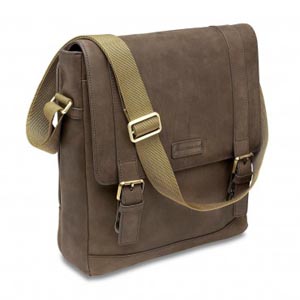
- Suits the environment in which it will be used
- Doesn’t look too much like a laptop bag; why have a bag that screams “THERE’S A LAPTOP IN HERE, THIS IS WORTH STEALING!” simply because someone wants their brand on the back in big letters
- Has decent padding and shock absorption - some hard cases also offer additional protection but must be padded against shock
- Has enough room to allow storage of the transformer, extra batteries, mice, etc. without putting undue pressure on the machine
- Shouldn’t compress or squeeze the laptop too much; this can be a problem for some backpacks as well
- Is easy to carry for a distance; for example a shoulder bag should have a carry handle AND strap
- Doesn’t fall over constantly when put down – some bags do this and can get stood on if they fall over leading to a very broken laptop. This is a very common problem with badly designed bags.




